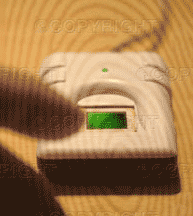Overview
|
Biometrics is the science and technology of measuring and analyzing biological data. In information technology, biometrics refers to technologies that measure and analyze human body characteristics, such as fingerprints, eye retinas and irises, voice patterns, facial patterns and hand measurements, for authentication purposes. Authentication by biometric verification is becoming increasingly common in corporate and public security systems, consumer electronics and point of sale (POS) applications. In addition to security, the driving force behind biometric verification has been convenience. Biometric devices, such as fingerscanners, consist of:
|
 |
To prevent identity theft, biometric data is usually encrypted when it's gathered. Here's how biometric verification works on the back end: To convert the biometric input, a software application is used to identify specific points of data as match points. The match points in the database are processed using an algorithm that translates that information into a numeric value. The database value is compared with the biometric input the end user has entered into the scanner and authentication is either approved or denied.
Why Use Biometrics?
Greater security and convenience
- Convenience: nothing to lose or forget
- Security: cannot be guessed, transferred or stolen and is unique
Higher productivity and lower costs
- No one is locked out because of lost cards or forgotten or expired passwords
- Less support calls.
Studies have shown that maintaining Windows passwords, for example, costs companies $150 per user, per year.
Biometrics Plays an Important Role in Physical Access Control
Biometrics identifies a person via a unique human characteristic: the size and shape of a hand, a fingerprint, oneís face or several aspects of the eye. If the goal of an access control system is to control where people, not credentials, can and cannot go, then only a biometric device truly provides this capability to the end user.
As a result, biometrics is used on the front doors of thousands of businesses around the world, at the doors to the tarmacs of major airports, and at the entrances of other facilities where the combination of security and convenience are desired.
More than 900 biometric hand readers control client and employee access to special areas of Italian banks and more than 100 units perform similar functions in Russia. In the united Kingdom, Her Majestyís Prisons rely on biometrics for prisoner and visitor tracking. Universities use hand readers for the on-campus meal program and to safeguard access to dormitories and to protect their computer centers. Hospitals utilize the biometric devices for access control and payroll accuracy.
Since 1991, biometric systems have produced millions of verifications at San Francisco International airport (SFO), with more than 50,000 produced on high volume days. Hand readers span the entire airport, securing more than 180 doors and verifying the identity of more than 18,000 employees. The use of biometrics at San Francisco is airport-wide and fully integrated into the primary access control system.
The Benefits of Biometrics in Access Control
The goal of any access control system is to let authorized people, not just their credentials, into specific places. Only with the use of a biometric device can this goal be achieved. A card-based access system will control the access of authorized pieces of plastic, but not who is in possession of the card. Systems using PINs require an individual only know a specific number to gain entry; but who actually entered the code cannot be determined. On the contrary, biometric devices verify who people are by what they are, whether by hand, eye, fingerprint, or voice recognition. Biometric reductions in errors have lowered the capital costs of ID cards in recent years and the true benefit of eliminating them is realized through reduced administrative efforts. For example, a lost card must be replaced and reissued by someone. Just as there is a price associated with the time spent to complete this seemingly simple task, when added together, the overall administration of a card system is costly.
Contrary to using badges, sign-ins or other ways of tracking employees, a biometric time clock assures that no employee can punch in for another, eliminating time fraud and reducing payroll costs. Because every personís biometric characteristic (hand, fingerprint, eyes, face, etc.) is unique, a biometric time clock provides a quick, accurate, and reliable way to record in- and out-punches for each employee. Thatís why so many companies now employ biometrics.